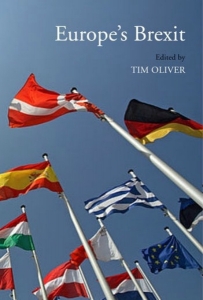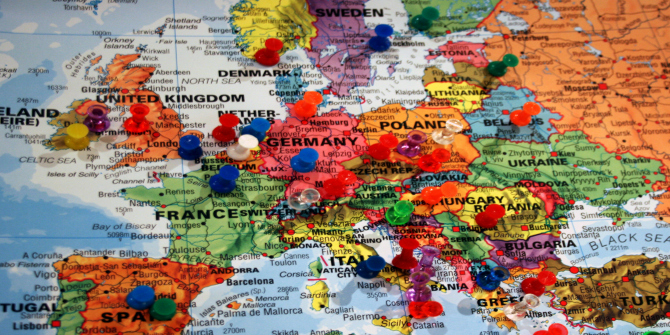In Europe’s Brexit: EU Perspectives on Britain’s Vote to Leave, editor Tim Oliver brings together contributors to refocus attention from the impact of Brexit upon the UK to instead consider the perspectives of the 27 other EU countries as well as the implications for EU institutions. This is a well-written collection that will prompt readers to better understand the desires, motivations and viewpoints of the different EU member states, finds Chris Stafford.
This book review has been translated into Spanish by Hanna Horst, Gabby Iorga and Marta Kozielska (Spanish LN785, teacher Esteban Lozano) and into Mandarin by Meizhi Chong (L340) and Dong Xiang (Economics) (Mandarin LN340, teacher Lijing Shi) as part of the LSE Reviews in Translation project, a collaboration between LSE Language Centre and LSE Review of Books. Please scroll down to read these translations or click to the Spanish review here and to the Mandarin review here.
Europe’s Brexit: EU Perspectives on Britain’s Vote to Leave. Tim Oliver (ed.). Agenda Publishing. 2018.
For many, the result of the UK’s referendum on European Union membership came as quite a shock. This was as true for Europe’s political elite as it was for much of the general public and even many of those advocating the ‘Leave’ option. Naturally, such a monumental event and the subsequent proceedings have warranted considerable coverage and analysis, but more often than not, the majority of this has focused primarily on the UK. The causes, consequences and meanings of ‘Brexit’ are all typically looked at from a British perspective, and it is commonly assumed that this issue is just as important to the rest of Europe as it is to the UK. However, it is easy to forget that when we talk about the EU, we are not just referring to an autonomous political entity, but rather to 27 other individual countries, each with their own problems and priorities, for which continuing issues relating to both the eurozone and migrant crises render the UK’s imminent withdrawal from the EU less important than the British might like to think.
It is here that Europe’s Brexit aims to contribute, with editor Tim Oliver stating in the introduction that the focus of the book is not the UK, but the countries and the institutions that will be left behind as it separates itself from the EU. Actors more central to the issues, such as Germany, France, Ireland, Poland and the EU institutions themselves, have been given their own chapters, while other member states have had to share, being grouped by geographical proximity. This serves to reduce the overall length of the book but without significantly compromising the extent of material covered. The ‘Benelux’ nations are a good example of this, as despite not being able to give as much individual attention to each country, Rem Korteweg and his co-authors manage to analyse the three nations with the same level of depth and insight that Vivien Pertusot does in a chapter focused solely on France.
The time period covered by the book is fairly brief in duration but significant and tumultuous in nature. Aside from some relevant history, the book primarily covers the 21-month period from June 2015, when then UK Prime Minister David Cameron informed the European Council that he wished to renegotiate the country’s terms of membership, up until March 2017, when his successor, Theresa May, informed the council that Article 50 was being triggered and Britain was to formally begin the process of leaving the EU.
 Image Credit: (Caitlin Regan CC BY 2.0)
Image Credit: (Caitlin Regan CC BY 2.0)
Despite the variation in the countries covered and the numerous different authors who contributed to this work, Oliver has managed to ensure remarkable consistency throughout the book. Each country is analysed according to how they responded and acted during four defined periods: namely, Britain’s pre-referendum renegotiations; the referendum campaign itself; the result of the referendum; and, finally, the divorce negotiations after the triggering of Article 50. However, even within this common structure, the authors have been able to tailor each chapter to focus on the issues that best reflect the actions of their respective country or countries.
When discussing Mediterranean member states, for example, Eleanora Poli and her co-authors present their information quite differently to how António Raimundo and Laia Mestres do on Spain and Portugal; but the shared yet flexible structure allows each chapter to present the subject matter in a manner best suited to each case. This also allows for easy comparison between the different countries and facilitates the construction of the bigger picture, without the chapters having to constantly reference each other.
This means that as the book progresses, it is clear to see the different approaches and motivations of various member states. Nicolai von Ondarza writes that countries such as Germany initially saw renegotiations as a technical matter and assumed the UK was too pragmatic to actually leave the EU; whereas Andrew Gilmore shows that due to its own experiences with EU referendums, Ireland was much less certain of a ‘Remain’ vote and was far more willing to appease the UK up to a point, due to the close economic, political and social links between the two countries.
Nevertheless, what is also striking is just how unified the member states have been throughout the period covered in the book, maintaining a united front and refusing to compromise on key issues such as the four freedoms of the single market, making negotiations much tougher for the UK government. In addition, they have all accepted that the figureheads of the EU institutions should be the ones to speak and negotiate on behalf of everyone, which helps to explain why despite its size and diversity, the EU is often presented as a single Brussels-based entity. This is in stark contrast to the UK where disunity and constant competition within the country, and perhaps more importantly within the government itself, are constantly making headlines.
However, one potential criticism of the book is that the distinctness of each chapter, in conjunction with the common themes that run throughout it, results in most of these issues being reiterated constantly in each new contribution, with the content thus becoming quite repetitive in places. Whichever country the discussion is focused on, be it France, Germany, Malta or the Czech Republic, regular references are made to how these countries have many other pressing concerns; how in the beginning they wanted the UK to remain a member but not at any cost; and then how after the referendum their focus was primarily on moving forward without the UK rather than how to actually separate. While it is of course interesting and relevant that certain themes and beliefs are so strong that they resonate across 27 very diverse nations, anyone reading the book from cover to cover will likely grow weary of these sentiments before too long.
These oft-repeated sentiments may also grind with a reader depending on their political viewpoint. Those more sceptical of European integration may find the view of an upbeat and unified EU27 quickly putting ‘Brexit’ behind them to be a rose-tinted view of the situation on the continent. On the other hand, those less enthusiastic about the ‘Brexit’ process may see this book as containing important lessons about Britain’s position in the world, both real and perceived, and how it could have better approached its relationship with Europe over the past few years.
Regardless, this is a well-written book that states its case clearly and highlights important issues that have often been lacking from other commentary and analysis thus far. While for many readers the book will prompt them to consider what could have been done differently up until now, the book’s key concept of understanding different national perspectives will be important to remember going forward. As the UK attempts to forge its own path in the world, making a concerted effort to understand the desires, motivations and perspectives of other nations will be crucial if it wants to make the most of its newly found ‘independence’.
Chris Stafford is a PhD student at the University of Nottingham, focusing on democracy and representation. His current research investigates how MPs have reacted to the result of the EU Membership Referendum and how this relates to the opinions of their constituents.
Note: This review gives the views of the author, and not the position of the LSE Review of Books blog, or of the London School of Economics.
En el Brexit de Europa: Perspectivas de la UE sobre el Voto de Salida de Gran Bretaña, el editor Tim Oliver reúne a los colaboradores para reorientar la atención del impacto del Brexit en el Reino Unido y considerar en su lugar las perspectivas de los otros 27 países de la UE, así como las implicaciones para las instituciones de la UE. Se trata de una colección bien escrita que incitará a los lectores a comprender mejor los deseos, las motivaciones y los puntos de vista de los diferentes Estados miembros de la UE, según Chris Stafford.
Brexit de Europa: Perspectivas de la UE sobre el Voto de Salida de Gran Bretaña. Tim Oliver (ed.). Agenda Publishing. 2018.
 Review translated by Hanna Horst, Gabby Iorga and Marta Kozielska (Spanish LN785, teacher Esteban Lozano).
Review translated by Hanna Horst, Gabby Iorga and Marta Kozielska (Spanish LN785, teacher Esteban Lozano).
Para muchos, el resultado del referéndum del Reino Unido sobre la adhesión a la Unión Europea supuso una gran sorpresa. Esto era tan válido para la élite política de Europa como para gran parte del público en general e incluso para muchos de los que defendían la opción de “irse”. Naturalmente, un evento tan monumental y los procedimientos subsiguientes han merecido una cobertura y un análisis considerables, pero en la mayoría de los casos, se han centrado principalmente en el Reino Unido. Las causas, consecuencias y significados del ‘Brexit’ se consideran típicamente desde una perspectiva británica, y se asume comúnmente que esta cuestión es tan importante para el resto de Europa como lo es para el Reino Unido. Sin embargo, es fácil olvidar que cuando hablamos de la UE, no nos referimos únicamente a una entidad política autónoma, sino a otros 27 países individuales, cada uno con sus propios problemas y prioridades, para los que los continuos problemas relacionados tanto con la crisis de la zona del euro como con la de los inmigrantes, hacen que la inminente retirada del Reino Unido de la UE sea menos importante de lo que a los británicos les gustaría pensar.
Es aquí donde el Brexit de Europa pretende contribuir, con el editor Tim Oliver afirmando en la introducción que el foco del libro no es el Reino Unido, sino en los países y las instituciones que dejarán atrás al separarse de la UE. A los actores más importantes en estas problemáticas, como Alemania, Francia, Irlanda, Polonia y las propias instituciones de la UE, se les han asignado sus propios capítulos, mientras que otros Estados miembros han tenido que compartir, agrupados por proximidad geográfica. Esto permite reducir la longitud total del libro, pero sin comprometer significativamente la extensión del material cubierto. Las naciones del “Benelux” son un buen ejemplo de ello, ya que, a pesar de no poder prestar tanta atención individual a cada país, Rem Korteweg y sus coautores consiguen analizar las tres naciones con el mismo nivel de profundidad y perspicacia que Vivien Pertusot en un capítulo dedicado exclusivamente a Francia.
El período de tiempo cubierto por el libro es bastante breve en duración, pero significativo y tumultuoso en su naturaleza. Aparte de algunos antecedentes relevantes, el libro cubre principalmente el período de 21 meses desde junio de 2015, cuando el entonces primer ministro del Reino Unido, David Cameron, informó al Consejo Europeo que deseaba renegociar los términos de membresía del país, hasta marzo de 2017, cuando su sucesora, Theresa May, informó al Consejo que el artículo 50 se activaba y que Gran Bretaña debía comenzar formalmente el proceso de salida de la UE.
 Image Credit: (Caitlin Regan CC BY 2.0)
Image Credit: (Caitlin Regan CC BY 2.0)
A pesar de la variedad en los países cubiertos y de los numerosos autores diferentes que contribuyeron a este trabajo, Oliver ha logrado asegurar una consistencia notable en todo el libro. Cada país es analizado de acuerdo a cómo respondió y actuó durante cuatro períodos definidos, a saber: las negociaciones previas al referéndum de Gran Bretaña, la propia campaña del referéndum, el resultado del referéndum y, finalmente, las negociaciones de divorcio tras la activación del artículo 50. Sin embargo, incluso dentro de esta estructura común, los autores han podido adaptar cada capítulo para centrarse en los temas que mejor reflejan las acciones de sus respectivos países.
Al discutir los estados miembros del Mediterráneo, por ejemplo, Eleanora Poli y sus coautores presentan su información de manera muy diferente a cómo lo hacen António Raimundo y Laia Mestres sobre España y Portugal, pero la estructura compartida, pero flexible, permite que cada capítulo presente el tema de la manera más adecuada para cada caso. Esto también permite una comparación fácil entre los diferentes países y facilita la construcción de un panorama de conjunto más amplio, sin que los capítulos tengan que referirse constantemente el uno al otro.
Esto significa que a medida que avanza el libro, se ven claramente los diferentes enfoques y motivaciones de los distintos estados miembros. Nicolai von Ondarza escribe que países como Alemania inicialmente vieron las renegociaciones como un asunto técnico y asumieron que el Reino Unido era demasiado pragmático para salir realmente de la UE, mientras que Andrew Gilmore muestra que, debido a sus propias experiencias con los referendos de la UE, Irlanda estaba mucho menos segura de un voto “permanecer” y mucho más dispuesta a apaciguar al Reino Unido hasta cierto punto, debido a los estrechos vínculos económicos, políticos y sociales entre los dos países.
Sin embargo, lo que también sorprende es cuán unidos han estado los estados miembros a lo largo del período cubierto en el libro, manteniendo un frente unido y negándose a comprometerse en temas clave, como las cuatro libertades del mercado único, haciendo las negociaciones mucho más difíciles para el Gobierno del Reino Unido. Además, todos han aceptado que las figuras representativas de las instituciones de la UE deben ser las que hablen y negocien en nombre de todos, lo que ayuda a explicar por qué, a pesar de su tamaño y diversidad, la UE se presenta a menudo como una única entidad con sede en Bruselas. Esto contrasta claramente con el Reino Unido, donde la desunión y la competencia constante dentro del país, y quizás más importante, dentro del propio gobierno, está constantemente en los titulares.
Sin embargo, una crítica potencial del libro es que la distinción de cada capítulo, junto con los temas comunes que lo acompañan, hace que la mayoría de estos temas se reiteren constantemente en cada nueva contribución, con lo que el contenido se vuelve bastante repetitivo en algunos partes. En cualquier país en el que se centre la discusión, ya sea en Francia, Alemania, Malta o la República Checa, se hacen referencias periódicas a estos países y a que tienen muchas otras cuestiones urgentes; cómo al principio querían que el Reino Unido siguiera siendo miembro, pero no a cualquier costo; y luego, después del referéndum, su enfoque se centró principalmente en avanzar sin el Reino Unido en lugar de considerar cómo separarse realmente. Si bien, por supuesto, es interesante y relevante que ciertos temas y creencias son tan fuertes que resuenan en 27 naciones muy diversas, cualquiera que lea el libro de principio a fin probablemente se cansará de estos sentimientos en poco tiempo.
Estos sentimientos a menudo repetidos también pueden demoler un lector dependiendo de su punto de vista político. Aquellos más escépticos de la integración europea pueden encontrar la optimista y unificada UE de los 27 que rápidamente se olvida de los problemas de “Brexit”, como una visión teñida de color rosa de la situación en el continente. Por otro lado, los menos entusiastas con el proceso ‘Brexit’ pueden considerar que este libro contiene lecciones importantes sobre la posición de Gran Bretaña en el mundo, tanto reales como percibidas, y cómo podría haber mejorado su relación con Europa en los últimos años.
En cualquier caso, este es un libro bien escrito que expone claramente su caso y resalta cuestiones importantes que a menudo han faltado en otros comentarios y análisis hasta este momento. Mientras que, para muchos lectores, el libro les pedirá que consideren lo que se podría haber hecho de manera diferente hasta ahora, el concepto clave del libro para comprender las diferentes perspectivas nacionales será importante para recordar cómo seguir adelante. Mientras que el Reino Unido intente hacer su propio camino en el mundo, hacer un esfuerzo concertado para comprender los deseos, motivaciones y perspectivas de otras naciones será crucial si el país quiere aprovechar al máximo su “independencia” recién descubierta.
Chris Stafford es estudiante de doctorado en la Universidad de Nottingham y se centra en la democracia y la representación. Su investigación actual explora cómo los parlamentarios han reaccionado ante el resultado del referéndum sobre la membresía de la UE y cómo esto se relaciona con las opiniones de sus electores.
Nota: Esta reseña ofrece los puntos vista del autor, y no las posiciones del blog de LSE Review of Books, o de LSE, London School of Economics.
Review translated by Meizhi Chong (L340) and Dong Xiang (Economics) (Mandarin LN340, teacher Lijing Shi)
 英国关于其欧盟成员国身份的公投结果吓到了许多的欧洲公众。从普通大众到政治精英,甚至“脱欧”支持者,个个对结果十分惊讶。自然,作为一个里程碑式事件,其结果及后续带来了相当多的报道与分析。但是,大多数的报道只专注于英国: 英国脱欧的原因、后果、和含义都是从英国的立场出发,并且假设这个事件对欧盟有同等的重要性。他们忘记欧盟不只是一个政治实体,而是由二十七个独立的国家组成的。各国有各自的问题和需要优先处理的事项,譬如欧元区和移民危机。这些问题对于这些国家比英国脱欧有更重要。
英国关于其欧盟成员国身份的公投结果吓到了许多的欧洲公众。从普通大众到政治精英,甚至“脱欧”支持者,个个对结果十分惊讶。自然,作为一个里程碑式事件,其结果及后续带来了相当多的报道与分析。但是,大多数的报道只专注于英国: 英国脱欧的原因、后果、和含义都是从英国的立场出发,并且假设这个事件对欧盟有同等的重要性。他们忘记欧盟不只是一个政治实体,而是由二十七个独立的国家组成的。各国有各自的问题和需要优先处理的事项,譬如欧元区和移民危机。这些问题对于这些国家比英国脱欧有更重要。
这就是《欧洲的脱欧》希望表达的:编辑Tim Oliver在前言中就已经明确的说明这本书并不是关注英国,而是关注那些被忽视的国家与机构。那些政治主体对问题更为重要的国家都有独立章节,比如德国、法国、爱尔兰、波兰、和欧盟机构;而其他成员国按地理位置分组。这减少了书的总长度,但没减少所涵盖的材料范围。一个很好的例子是比荷卢三国:虽然作者并不单独关注每个国家,但Rem Korteweg和合著者对三个国家的洞察深度不逊舍于Vivian Pertusot对法国的章节的分析。
这本书所涵盖的时间段即使相当短暂,但本质上重大且动荡。除了描述相关历史以外,这本书主要涵盖起自2015年6月直到2017年3月这21个月的期间。始于英国首相大卫·卡梅伦向欧洲理事会表达重新谈判英国成员资格的意愿起,止于他的继任者特丽莎·梅告知理事会第50条被触发且英国将正式开始离开欧盟的进程。
 Image Credit: (Caitlin Regan CC BY 2.0)
Image Credit: (Caitlin Regan CC BY 2.0)
尽管这本书包含了很多不同的国家,许多不同的作者也为这本书做出了贡献,但Oliver仍旧在整本书中确保了非凡的一致性。每个国家通过分析其反应及行为定义出四个时期。这包括:英国的公投前重新谈判、全民投票运动、全民投票的结果、在触发第50条之后的谈判。虽然有相同的写作结构,但每个作者能润色每一章节并专注于最能反应各自国家或地区行为的问题。
比如,当这本书在讨论地中海成员国时,Elanora Poli和她的合作者提供的信息与Antonio Raimundo 和 Laia Mestres 在西班牙的葡萄牙的表现完全不同。这种同中求异的结构使每章的主题以最适合其情况的方式呈现。另外,这也使不同国家之间的比较变得容易,并且有助于整体的宏观对比,而不必不断地相互参照不同章节
这表示随着这本书的进展,读者可以清楚地看到个成员国的不同方法和动机。Nicolai von Ondarza 写道,像德国这样的国家最初将重新谈判视为技术问题,并认为英国实际上离开欧盟过于务实。但Andrew Gilmore表示,由于其自身在欧盟公投中的经历,爱尔兰当时不太确定英国的公民会投“保留”的票。并且,由于两国之间密切的经济、政治、和社会的联系,爱尔兰更愿意对英国妥协。
然而,同样引人注目的是成员国在整本书所涵盖的时期内保持团结,保持统一的战线、拒绝在单一市场的四项自由等关键问题上妥协,使英国政府谈判更加艰难。另外,成员国都同意欧盟机构的名义首领应该是代表每个人发言和谈判的人。这有助于解释尽管欧盟有的规模和多样性,为什么欧盟通常呈现为单一的布鲁塞尔实体。这与英国政府目前所面临的情况形成鲜明对比。在英国,国内的政治分裂和激烈竞争经常成为公众所关注的头条新闻。
可是,这本书潜在的批评在于每个章节独立成篇,部跟其他章节的共同主题连接。导致同样的主题和内容在每个新作者的章节里不断重复。无论是对哪个国家的议论,比如法国、德国、马耳他或捷克共和国,作者会提出同样的主题。包括:这些国家如何面临其他更紧迫的问题、这些国家当初如何希望有条件地把英国留在欧盟。在公投之后,它们关注如何在跟英国分割的情况下继续向前,而不是讨论如何与英国切割的实际措施。我不否认这些主题很有意思也很相关,而信仰如此强大以至于完全不同的二十七个国家产生共鸣。但是,任何读者从头看到尾很可能很快就会厌倦这些看法。
由于读者的政治观点不同,不断重复的观点会也许遭到一些读者的排斥。那些怀疑欧洲一体化的人有可能会觉得欧盟27国快速置英国脱欧而不理,向前迈进的乐观统一的观点太过简单化。另一方面,那些对英国脱欧过程不太踊跃的人可能会认为这本书包含了重要的教训。他们从中能学到英国实际的和想象的世界地位,以及英国过去几年应该如何更好地与欧洲建立的关系。
无论如何,这本书写得很好,重点明确,并且突出了迄今为止其他评论和分析中经常缺乏的重要问题。虽然对很多读者而言, 这本书引发他们去思考什么可以做得不同, 但了解和记住不同国家对于该话题的观点对我们的前进很重要。如果英国试图在世界上打造自己的新道路,它必须在国内齐心协力, 同时了解其他国家的需求、动机、和观点。


 Find this book:
Find this book: 





4 Comments